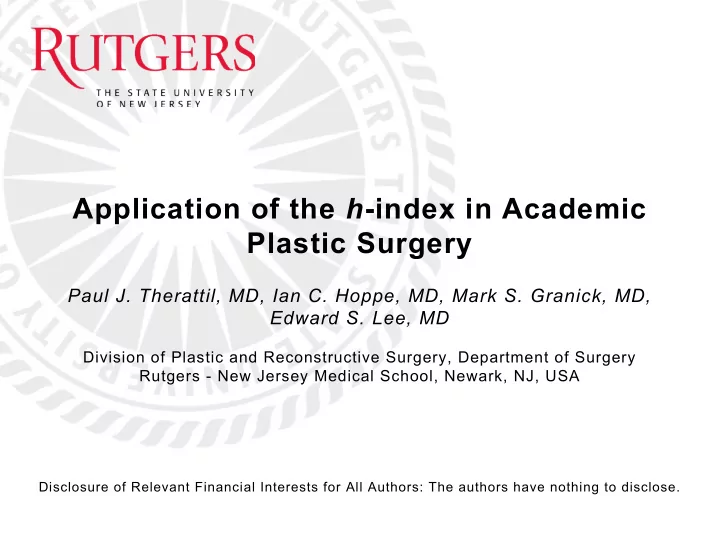

Application of the h -index in Academic Plastic Surgery Paul J. Therattil, MD, Ian C. Hoppe, MD, Mark S. Granick, MD, Edward S. Lee, MD Division of Plastic and Reconstructive Surgery, Department of Surgery Rutgers - New Jersey Medical School, Newark, NJ, USA Disclosure of Relevant Financial Interests for All Authors: The authors have nothing to disclose.
Application of the h -index in Plastic Surgery Introduction • When determining the performance of an academic physician, patient care, teaching, and research are among the most critical attributes surveyed. • With regard to research, total number of publications, research grants, and mentorship are important factors. • The gross number of a physician’s publications, however, may produce a skewed picture of his or her academic contributions.
Application of the h -index in Plastic Surgery Introduction • The h -index is an objective measure used to determine how prolific an author is while taking into account the impact of his or her publications. • The h -index of an author is equal to the numbers of papers, h , that have been cited at least h times.(1) • The index was initially used mainly outside of the medical literature, but in recent years its applicability in multiple medical fields has been tested and validated.(2-6)
Application of the h -index in Plastic Surgery Objective • The purpose of this study was to determine whether the h -index could be applied to plastic surgery to differentiate between surgeons of different rank, and to determine what other variables may affect scholarly productivity.
Application of the h -index in Plastic Surgery Methods • A database of all US academic plastic surgeons was created. Characteristics of each surgeon and their plastic surgery program were collected. The Scopus database was queried to determine each surgeon’s h - index. • Nonparametric statistical analysis and multivariate analysis was performed.
Application of the h -index in Plastic Surgery Results h -index p value Academic rank Mean ± SE Median Range < 0.0001* ☨ Assistant Professor (n = 268) 4.59 ± 0.24 4 0-24 Associate Professor (n = 141) 9.10 ± 0.46 8 0-26 Professor (n = 183) 15.30 ± 0.68 14 1-65 Chief (n = 60) 13.60 ± 1.34 11 2-65 0.24 Chairperson (n = 22) 15.41 ± 2.08 14.5 5-43 Model of residency training program < 0.0003* ☨ Integrated (n = 459) 9.64 ± 0.39 8 0-65 Traditional (n = 124) 6.28 ± 0.42 5.5 0-19 Gender Male (n = 491) 9.57 ± 0.26 8 0-65 < 0.0001* Female (n = 101) 6.07 ± 0.63 5 0-40 Size of plastic surgery faculty 0.0186 ☨ Less than 6 faculty members (n = 191) 7.45 ± 0.41 7 0-31 6 or more faculty members (n = 401) 9.70 ± 0.43 8 0-65 Status of plastic surgery section Department (n = 187) 8.95 ± 0.40 7 0-65 0.65 Division (n = 405) 9.02 ± 0.54 7 0-43 Table 1. h -index of US academic plastic surgeons by rank, model of residency program, gender, faculty size, and departmental status. (*) = Statistically significant on univariate analysis, and ( ☨ ) = significant on multivariate analysis.
Application of the h -index in Plastic Surgery Results Figure 1. Frequency distribution of the h -index for 592 academic plastic surgeons.
Application of the h -index in Plastic Surgery Results Figure 2. Box-and-whisker plot depicting h -index values of plastic surgeons as a function of academic rank ( p < 0.0001 across all academic ranks).
Application of the h -index in Plastic Surgery Results Figure 2. Box-and-whisker plot depicting h -index values of plastic surgeons as a function of the residency training model of their institution ( p < 0.0003).
Application of the h -index in Plastic Surgery Results Figure 3. Box-and-whisker plot depicting h -index values of plastic surgeons as a function of gender ( p < 0.0001). Not significant on multivariate analysis.
Application of the h -index in Plastic Surgery Results Figure 2. Box-and-whisker plot depicting h -index values of plastic surgeons as a function of region ( p = 0.12).
Application of the h -index in Plastic Surgery Conclusions • The h -index of plastic surgeons appears to correlate with academic rank and can measure academic productivity within plastic surgery. • Plastic surgeons on faculty in integrated plastic surgery programs tend to have higher h -indices. • Male plastic surgeons tend to have higher h -indices, although this is a result of the small number of females at higher academic ranks. • There does not appear to be a regional difference with regard to h -indices.
Application of the h -index in Plastic Surgery References 1.Hirsch JE. An index to quantify an individual's scientific research output. Proceedings of the National Academy of Sciences of the United States of America 2005;102:16569-16572 2.Lee J, Kraus KL, Couldwell WT. Use of the h index in neurosurgery. Clinical article. Journal of neurosurgery 2009;111:387-392 3.Rad AE, Shahgholi L, Kallmes D. Impact of self-citation on the H index in the field of academic radiology. Academic radiology 2012;19:455-457 4.Benway BM, Kalidas P, Cabello JM, et al. Does citation analysis reveal association between h-index and academic rank in urology? Urology 2009;74:30-33 5.DeLuca LA, Jr., John AS, Stolz U, et al. The distribution of the h-index among academic emergency physicians in the United States. Academic emergency medicine: official journal of the Society for Academic Emergency Medicine 2013;20:997-1003 6.Pagel PS, Hudetz JA. An analysis of scholarly productivity in United States academic anaesthesiologists by citation bibliometrics. Anaesthesia 2011;66:873-878
Recommend
More recommend